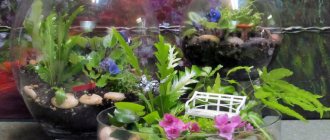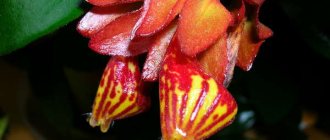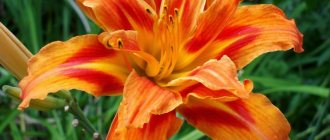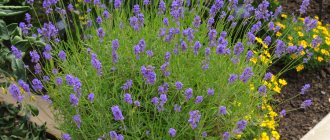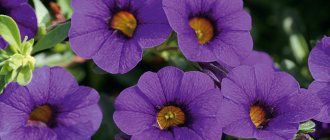Popularly nicknamed “lingonberry” or “goldfish,” nematanthus is one of the most spectacular indoor crops with beautiful flowering. Developing in the form of compact bushes or ampels, the plants are equally captivating with their dense, shiny, dark-colored leaves and flowers, the unusual shape of which truly resembles goldfish. Despite their growing popularity, these plants remain full-fledged indoor exotics. And the point is not only that the bright appearance of nematanthus sets it apart from its tropical competitors. Growing them is not at all difficult, but they require very careful, careful care.
Nematanthus gregarius. © floradania
Impeccable greenery and strange flowering nematanthus
There is a lot of confusion associated with the name nematanthus hypocyrta are also considered to be in the same genus with the native species of South American crops, belonging to the Nematanthus group . Despite the fact that in the genus Nematanthus there are still separate groups of plants based on the structural features of flowers and inflorescences, they are all surprisingly similar to each other both in growth forms and in the type and attractiveness of foliage.
In our country, the name “hypocyrtus” is still very common. But according to all modern botanical classifications, it is more appropriate to call this plant nematanthus. Folk nicknames that glorify the similarity of flowers with either goldfish or lingonberries are relevant for all plants included in this genus. The English name 'Goldfish plant' is also popular.
Despite the fact that the most striking detail in the appearance of nematanthus remains the exotic flowering, these plants can rightfully be called crops that have equally attractive flowers of outlandish shape and beautiful classic fleshy leaves. During flowering, nematanthus truly seems like a real miracle: original yellow or orange flowers flash on a luxurious crown of dark leaves and elegant shoots, somewhat reminiscent of noble boxwoods.
In nature, nematanthus develop as epiphytic subshrubs or full-fledged vines. But plants adapted for growing in greenhouses and rooms are mainly formed in the form of shrubs. Compact, elegant and dense bushes of numerous straight, ascending, climbing or creeping shoots captivate with a very dense, attractive crown with beautiful growth forms. All nematanthus are plants of compact size, even at a significant age, not exceeding 10-60 cm in height. But the rather modest size is not a disadvantage, but rather a huge advantage of this crop.
Nematanthus are characterized by a unique ability to harmonize space, favorably influence the visual perception of rooms, and create a feeling of greater spaciousness. At the same time, small forms prevent the plant from having a negative impact on the interior, and bright external details allow these crops to always and everywhere remain noticeable and important accents. The amazingly beautiful silhouettes and graceful forms of nematanthus are best revealed as solo, elegant interior decorations.
Climbing or creeping shoots of nematanthus are capable of rooting in nodes, are densely leafy, and the type of structure of the branches and the nature of the placement of leaves resembles boxwoods or lingonberries and blueberries. Dense, fleshy, succulent leaves are not so small in size (from 3 to 10 cm), glossy and seemingly shiny surface distinguishes nematanthus from other indoor crops. The leaves of the plant are obovate or elliptical, beautiful, with a deep midrib. The intense dark green color contrasts effectively with the purple or light reverse side and is emphasized by a glossy sheen.
These evergreen crops boast strikingly noble textures of greenery, captivating with their severity, simplicity and at the same time impeccable appearance. During almost the entire warm season, the spectacular dark green background is colored with fancy flowers, the shape of which makes them look more like wax fruits or unusual berries. The strange nematanthus flowers bloom directly in the axils of the leaves. They are tubular, with a narrowed, almost completely closed mouth, unusual dense textures and an original convexity in the lower part.
The pocket-shaped shape of the corolla with swelling is expressed differently in different types of nematanthus: among them there are plants with a more modest and classic appearance, and more original and unusual ones. But the flowers of this plant do not leave anyone indifferent. They evoke many associations with pears, caroms, animals, various berries and tropical fruits. The unusual nature of nematanthus flowering is only emphasized by the fiery palette of colors. Yellow, orange and orange-red replace each other in soft watercolor variations, and the play of halftones and individual nuances of the color scheme makes the plants even more interesting.
Southern nematanthus (Nematanthus australis). © floradania
Botanical description of the plant
Nematanthus is classified as an epiphytic vine of the order Gesneriaceae. It is also correct to call it Hypocyrta nematanthus, since the genus Nematanthus is combined with the class Hypocyrta. It grows naturally in the rainforests of the Amazon in the form of small shrubs and vines. Settles on tree branches, fallen trunks, and loose soil.
The leaves of Nematanthus are fleshy, shiny, and ovoid in shape. The color of the foliage is heterogeneous: on the outside it is bright green, and on the inside it is multi-colored: from burgundy to lilac. Young leaves are straight, but later they bend and droop under the load of their own weight.
The buds are waxy, with petals 5 cm long converging inward. They are formed on a short stalk. Goldfish blooms with pink, yellow, orange, ruby and purple flowers from early spring to late autumn.
Did you know? The name of the flower was given by the German biologist G.A. von Schröder, combining two Greek words “νημα” - thread, hair, and “άνθος” - flower. The interpretation exactly means
"
a flower on a graceful peduncle
.
" The flower is grown as an hanging decoration in hanging containers or flower pots. It is predominantly an indoor species, the height of which does not exceed 60 cm.
| Root system | Aerial, develops in the leaf axil |
| Stem | Curved, creeping or erect |
| Leaf Shape | Oval |
| Leaf color | Above - bright green, below - a palette from burgundy to purple |
| Flower shape | Tubular, funnel-shaped, with a pocket-shaped rim, similar to an aquarium fish |
| Flower color | Pink, purple, yellow, red, orange |
| Fruit shape | Seeds are formed in a box |
Species diversity of nematanthus
This plant belongs to the Gesneriev family. The genus is represented by 28 species, which are often combined into separate subgroups based on flowering characteristics. 7-8 species are common in indoor culture.
- Nematanthus Wettsteinii is the most common species. It was formerly known as hypocyrta dusenii and hypocyrta wettsteinii. This is an excellent hanging and potted plant, producing numerous climbing shoots up to 90 cm long, on which small oval, brightly shiny leaves flaunt. They captivate with their waxy glossy surface and rich dark green color. Between the leaves, orange-red tubular flowers with a slight swelling, reaching about 2.5 cm in length, look like outlandish fruits. This nematanthus is capable of blooming tirelessly from spring to mid-autumn.
- Much less common is Fritsch's nematanthus (Nematanthus fritschii), better known as the "goldfish", and formerly called Fritsch's hypocyrta fritschii. This is a fairly large species with beautiful green leaves decorated with a reddish underside with a light edge, forming bushes up to 60 cm high with bright pink, funnel-shaped, unusually curved flowers and very large leaves.
- Riverside nematanthus (Nematanthus fluminensis) is an excellent climbing indoor plant with fairly large, opposite leaves up to 10 cm long, with a purple reverse side. The flowers of this species are elongated, lemon-yellow, up to 5 cm in length, with an unfolded throat, unlike most nematanthus, and a pubescent tube on the outside.
- Nematanthus longipes is a climbing subshrub with unusually light and large leaves for this genus, reaching 7-10 cm in length, almost equally long thin pedicels and single scarlet-red flowers with a strong swelling on the tube.
- Nematanthus strigillosus , formerly known as Hypocyrta glabra and Hypocyrta strigillosa, is an evergreen epiphyte limited to a height of 20-25 cm, producing ascending or straight, rarely branched shoots with oval, small and shiny leaves and tubular flowers blooming one by one or in bunches of up to 3 pieces. The tube has a spherical swelling, a rim with a small bend, and the color is a classic yellow-orange.
Separately, it is worth highlighting the hybrid nematanthus, which, thanks to long-term selection, have acquired an expressive, very strong smell. The rare but unique variety "Santa Teresa", for example, produces a few flowers that can fill even a large room with an intense aroma, reminiscent of a mixture of olive oil with citrus zest. But the hybrid Nematanthus Tropicana, in addition to the beauty of glossy, densely planted leaves, also offers yellow-orange flowers with spectacular golden and red stripes and is more famous not for its aroma, but for the beauty of its flowers.
Nematanthus Wettsteinii
Nematanthus gregarius. ©Bellatrix
Nematanthus hybrid. © floradania
Why does the goldfish have so many “fans”?
Translated from Greek, the name is “nematanthus”... No, it’s not a “fish” at all, but a “flower on a thread” - its peduncle is very thin. The flower is also called hypocyrta. Actually, it used to be a separate genus, but later botanists decided that both flowers were more than “cousins”, and they combined Nematanthus with Hypocyrta into a single genus.
“In the wild,” such plants live in Brazil, and in other countries of South America too.
In essence, this is a plant consisting of continuous advantages. It has small, glossy leaves, as if cast from plastic, and elongated flowers of an original shape. Since nematanthus leaves have succulent properties, it is not afraid of light droughts.
Young nematanthus are grown in pots, adults - in hanging baskets, as this is an excellent hanging crop.
This beauty blooms from spring to autumn, and does not skimp on flowers.
...Oh, if only I could fulfill wishes, this flower wouldn’t even have a price!
The most popular types of nematanthus
There are exactly 28 species in the genus Hypocyrtus. I’ll tell you about several that are sold here (although amateurs and breeders are not asleep, and there will probably be a species in your favorite store that will not be on the list below).
Prirechny. The plant is distinguished by yellow (sometimes white) flowers. It has climbing shoots. The lower part of the leaves is reddish.
Fritcha. The bush grows up to 60 cm. It has a pubescent stem and pink flowers.
Wetstein. An ampel flowerpot, the shoots of which grow to almost a meter. The flowers are small (but very abundant), the color of the petals is orange.
Tropicana. The species is distinguished by pointed leaves. The flowers are dark orange at first glance, but if you look closely, you can see that their main color is yellowish, but each petal is covered with dark stripes. They are no longer fish, but some bees!
Gregarius. The most “basic” nematanthus, which is sold in most stores. Its flowers are yellow-red and golden. It is they who resemble those very notorious fish.
Long-legged. This plant is an epiphyte, which is a subshrub. Its flowers are reddish-coral (this color is called scarlet).
Folk superstitions associated with this flower
You will definitely like them!
They say about the goldfish: it attracts wealth and happiness into the home, and just a great mood.
Also, many believe that the flower perfectly purifies the air (but I think that this is no longer a superstition, but science).
Caring for nematanthus at home
Nematanthus are not at all capricious and overly demanding indoor crops. Even their exotic status and unusual flowering are not signs that growing these plants will be beyond the power of inexperienced gardeners. But since this crop needs regular and very careful care, reacts poorly to improper watering and fertilizing, and requires annual pruning, negligence in growing nematanthus is unacceptable. The only difficulty associated with creating conditions that are comfortable for any nematanthus is providing a cool winter, which is the key to the abundant flowering of this indoor plant.
In the development of nematanthus, periods of dormancy, active development and preparation for flowering are clearly expressed. In nature, nematanthus bloom in the summer, but in indoor cultivation, the period during which the bushes are decorated with strange flowers stretches for a very long time until October. After shedding flowers, and in some species, completely shedding leaves, the plant enters a winter dormant period, which should be accompanied by a change in temperature and care.
Lighting for Nematanthus
Nematanthus can be considered light-loving indoor plants. They love stable lighting throughout the year: in seasons when most indoor plants suffer from a lack of light, nematanthus need to be either supplemented with light or moved to brighter places. In winter, this culture is not afraid of even the sunniest places and southern window sills. During the active period of growth and flowering, the brightest locations are chosen for them on eastern and western window sills or in the brightest places in the interior with panoramic windows - the nematanthus needs to be provided with stable, bright, diffused lighting.
Despite the fact that the density of Nematanthus leaves is in many ways reminiscent of the hardiest succulents, this plant does not tolerate direct sunlight and suffers greatly from burns when placed on south-facing window sills without appropriate dispersion. Nematanthus can tolerate light shading only in the hottest months of the year. Regular partial shade or shadow will cause the plant to bloom much more sparingly or cause its absence altogether. But partial shading does not affect the beauty of the leaves in any way.
One of the main advantages of nematanthus is the ability to grow equally well in natural bright light and in full artificial light. Thanks to its good response to artificial lighting, this crop can be used in interior design in any way you like.
Comfortable temperature conditions
The most difficult thing in growing nematanthus is the selection of comfortable temperature conditions. In this regard, the plant is not much different from other beautifully flowering indoor plants, in the development of which a period of almost complete dormancy is pronounced. The phase in development that the plant needs to rest and prepare for future flowering requires the creation of cool conditions. In winter, only a temperature range from 14 to 16 degrees Celsius will be comfortable for nematanthus. Stability and constancy of temperatures are no less important than their specific indicators.
If the nematanthus is in a warmer environment at the dormant stage, it will bloom very sparingly, for a limited period of time in the summer, or may not bloom at all. Usually the plant itself signals that it should be transferred to cooler conditions. After the nematanthus has dropped all its flowers, and for some species of the former hypocyrtus - and leaves, the plants require mandatory annual pruning, after which they should be placed in winter maintenance.
But in the warm season and at the stage of active development, nematanthus will not require any atypical conditions. These crops are quite comfortable in the usual “room” temperature range: from the beginning of spring to mid-autumn they are content with any conditions not exceeding 20 degrees Celsius. These plants, as a rule, achieve the greatest decorativeness and profuse flowering at a stable temperature of 20 to 25 degrees Celsius. If the temperature drops below 20 degrees, the plants may stop flowering.
When choosing suitable temperatures for keeping nematanthus, it is necessary to remember that this exotic, despite all its classical beauty, is very sensitive to temperature changes and fluctuations in keeping conditions. Severe cold snaps are especially dangerous for nematanthus, but heat also adversely affects the ability of plants to bloom profusely and for a long time. This culture should be protected in every possible way from any drafts and sudden temperature changes.
True, intolerance to even the slightest drafts is surprisingly combined in Nematanthus with a love of fresh air in the summer, in the hottest months. Thanks to this last characteristic, Nematanthus can be placed in protected places outdoors.
Nematanthus gregarius. © Barbara
Watering and air humidity
If the temperature regime is the most difficult moment when creating growing conditions that are comfortable for nematanthus, then in caring for the plant the most difficult component is rightly called maintaining the humidity of the substrate. It is watering that determines that this plant needs scrupulous, very careful and tireless care. Nematanthus are moisture-loving plants that require abundant watering. But at the same time, simply carrying out procedures quite often is unacceptable for this culture.
Before each watering, it is necessary to strictly control the degree of drying of the substrate, maintaining stable soil moisture in the pots. Abundant and frequent procedures, between which only the top layer of the substrate dries out, are necessary for the plant throughout the entire active period of development. Excessive soil moisture should not be allowed, nor should it dry out even in the middle layer. After each procedure, the water from the trays must be drained immediately, not allowing it to stand even for the standard 5 minutes.
One of the difficult aspects is the need to keep plants in much drier conditions in winter compared to the period of active growth. During the entire dormant phase for this plant, it is necessary to maintain a stable, but very light moisture content of the substrate, still not allowing it to dry out completely even for several hours, but at the same time drying between procedures not only the top, but also the middle layer of soil in the pots. Starting in the fall, watering should become moderate, infrequent, using a minimum amount of water. At the same time, the main difficulty is the correct transition to the winter maintenance regime.
You need to reduce watering as smoothly as possible, gradually, slowly. Despite the fact that plants should be transferred to a winter watering schedule only after the end of the flowering period, it is necessary to begin to reduce the frequency of procedures even when the nematanthus is blooming. Ideally, it is necessary to reduce watering within a month, but if the transition cannot be started on time, then the plants still need to be transferred to new conditions for at least 2 weeks.
The nematanthus partially compensates for its capriciousness to watering by being much more labile to air humidity. For him, the most comfortable environment is with a humidity of 50%. Nematanthus feel good in any residential premises, with the exception of periods of extreme summer heat and the operation of central heating systems. If the air is too dry, it is advisable to increase the humidity level either by spraying or by installing simple homemade humidifiers in the form of trays with wet pebbles or expanded clay. Spraying plants is complicated by the fact that moisture accumulation is undesirable not only on flowers, but also on leaves.
For this crop, it is necessary to use fine sprayers and spray high above the plant, so that even the slightest drops of moisture are dispersed before hitting the greens. Another feature in procedures for increasing air humidity is that for nematanthus they are never carried out during the dormant period. From the moment they enter the final phase of flowering, spraying is gradually reduced, and after the mandatory pruning has been carried out, they are completely stopped. Wintering in dry air complements changes in temperature and care, which stimulate more abundant and prolonged flowering in the nematanthus next year.
When purchasing nematanthus, be sure to check the air humidity it requires, because many hybrid varieties are well adapted to dry conditions and do not need any other conditions even on the hottest days.
Special attention should also be paid to water for watering and spraying this plant. For nematanthus, as for most indoor plants, you can only use well-settled water. But the main parameter is temperature. For nematanthus, it is better to use slightly warm water, the temperature of which is several degrees higher than the air temperature in the room.
Nematanthus. © floradania
Feeding for nematanthus
The fertilization schedule for nematanthus should fully correspond to the stages of plant development. From October to February, during the dormant period, fertilizers cannot be applied in any form. But during the period of active growth, especially when releasing young shoots and throughout the entire flowering stage, nematanthus need fairly frequent feeding. For them, it is advisable to use the full dose of fertilizer recommended by the manufacturer, applying them at a frequency of 10 or 15 days between procedures. You should not feed this crop more than once every 10 days.
For nematanthus, special fertilizers for flowering crops with a high content of potassium and phosphorus are most suitable.
Pruning nematanthus
Unlike most indoor crops with such succulent, fleshy leaves, nematanthus needs annual pruning. Formative pruning of the plant is carried out at the end of the active growth stage, immediately after flowering and usually at the beginning of leaf shedding in species formerly known as hypocyrtans. Without annual pruning, nematanthus will not only lose the beauty and density of the crown, its silhouette, density, but also the nature of the foliage towards a more sparse arrangement of leaves. But the most important consequences always concern flowering. Nematanthus produce flowers on young shoots, so without pruning before the dormant stage they will bloom very sparingly or not bloom at all.
The pruning procedure itself is extremely simple. All shoots of this plant are shortened by 1/3 of the length. For old nematanthus in need of rejuvenation, pruning is carried out to 1/2 of the length of the branches.
Nematanthus. © Barbara
Monetolia (Nummularia)
Nematanthus Monetolifolia is a hanging plant with short, fleshy, rounded leaves that are light green in color. Stem and leaves with fluff. The flowers are bright red, yellowish on the folds. Coinfolia Nematnthus sheds its leaves after flowering . In the photo you can see what this view looks like.
Nematanthus has a huge variety of species, so it will not be difficult to choose any flower depending on your wishes and place a piece of tropical Brazil in your home.
Transplantation and substrate
Finding suitable soil for this crop is not so easy. For comfortable development, it is necessary to provide a very light, loose substrate with good air and water permeability for a person who loves abundant watering during the entire active growth phase of the nematanthus. The optimal composition for these plants is soil mixtures for Saintpaulias or any ready-made substrates consisting of equal parts of leaf soil, peat and coarse sand with the addition of pieces of pine bark or sphagnum.
The compact size of nematanthus is explained by fairly moderate growth rates and slow development. Nematanthus do not actively grow not only above-ground shoots, but also rhizomes. And thanks to this, they do not need very frequent, and even more so annual, transplants even at a very young age. The optimal frequency of procedures for this plant is one transplant every 2-3 years. At the same time, you always need to focus on the development of the plant itself, the pace at which the roots fill the earthen lump.
With the timing of transplantation, everything is much simpler. The substrate capacity for nematanthus is changed as soon as the first signs of growth of new shoots and leaves appear, at the very beginning of spring.
The procedure itself is carried out using standard transfer techniques with minimal removal of only the free substrate and the top contaminated layer of soil. The plant must be handled very carefully, trying to avoid even the slightest contact with the roots, especially to avoid injury or breaking off even peripheral roots. For nematanthus, it is very important to lay a strong and high layer of drainage, which ensures that your plant does not suffer from waterlogging.
Pay special attention to the fact that when replanting nematanthus, the containers cannot be increased by more than 2-3 cm. This plant has a small rhizome, for which compact, medium-sized pots are selected. A spacious container increases the risk of developing diseases and pests, poor soil permeability and disruption of stable substrate moisture. And in large containers all nematanthus bloom very poorly.
Diseases and pests
Nematanthus cannot boast of the status of a stable, invulnerable houseplant. Pests simply adore them, and with the slightest problems with care or the wrong choice of conditions, traces of aphids, spider mites or scale insects can be seen on the beautiful crown of the bushes. For this plant, the difficulty of pest control is due to the fact that mechanical treatment methods are unacceptable and problems can only be dealt with with the help of insecticides. Of the diseases for nematanthus, the greatest danger is represented by rot, which spreads when the substrate is waterlogged. But this plant can also suffer from powdery mildew, which must be combated by treating it with fungicides.
Common problems in growing nematanthus:
- the leaves on the bushes turn yellow due to low air humidity and too frequent fertilizing;
- the appearance of spots and dry fragments on the leaves when exposed to direct sunlight or heat;
- dropping buds and leaves at too low temperatures and dampness;
- weak or absent flowering due to insufficient lighting, disturbances during the dormant period, lack of pruning, incorrect choice of substrate or feeding regime;
- the appearance of brown spots on the leaves when using too cold water and improper watering.
Nematanthus hybrid. © floradania
Difficulties in growing
Problems in cultivating nematanthus appear due to improper care.
Diseases
If there is little air movement in the room where nematanthus is grown, the plant may become infected with fungal diseases. In this situation, it is treated with fungicides.
Common diseases:
- Gray rot. The sign is a gray fluffy mold that appears on the plant. For treatment, the affected parts are removed and the moldy soil is replaced. Then they are treated with fungicides (Fundazol). In addition, you need to reduce watering, stop spraying and ventilate the room more often. As a preventive measure, you should follow the rules of hydration: do not allow high humidity in a cool place.
- Rot. It manifests itself as massive wilting of leaves, which then turn yellow and die. Treatment should begin immediately. First of all, the plant is removed from the container and the root system is examined: if it is softened and darkened, it is too late to treat the flower. If most of the roots have retained their elasticity, then you can compete for the flower. To do this, carefully remove the areas affected by rot, dry them and transplant them into a new substrate, which is watered with “Carbendazim”. Preventive measures: the plant is planted in a calcined pot and soil, ensure high-quality drainage, and prevent moisture stagnation.
- Powdery mildew. It appears as a whitish coating on the foliage and stems. When the lesion occurs in a small area, the plaque is removed manually. If the entire leaf is infected, it is removed. Additionally, the flower is treated with sulfur or Fitosporin-M. As a preventive measure, the room should be ventilated more often.
Pests
The following insects are dangerous for goldfish:
- Whitefly. Some people advise treating the plant with a vacuum cleaner - “pulling in” the parasite.
- Aphid. It can be detected by twisted buds and stems, which later dry out. For the fight, drugs based on permethrin, Antitlin, Biotlin are used.
- Thrips. As a result of their vital activity, the plant slows down in development, the flowers are deformed, and silvery streaks are noticeable on the leaves. At the first signs they are treated with Akarin, Fitoverm, Actellik.
- Spider mite. These parasites are dangerous because they suck the sap from the plant and reduce immunity. The pest is identified by the condition of the leaves: they are covered with yellow spots and cobwebs. You can save the plant by spraying it with a soap solution or special products (“Akarin”, “Fitoverm”, “Aktellik”, “Kleschevit”).
- Mealyworms. Their presence is indicated by “cotton” formations in the axils of the leaves, where these insects usually like to be located. Over time, the leaves wither and die. You can save yourself from pests by treating all parts of the plant with a swab soaked in alcohol.
Did you know? In Poland, nematanthus is called
"
humpbacked flower
"
, in Germany -
"
kiss
"
.
Reproduction of nematanthus
Propagating plants at home is complicated by limited methods. Nematanthus seeds practically do not ripen and very rarely sprout, and this culture does not form daughter plants, without releasing root shoots. Nematanthus cannot be obtained by dividing adult bushes. So the only method of propagation for nematanthus is cuttings. Cuttings can be taken both in spring and throughout the summer, choosing powerful, mature shoots with 4-5 internodes (both apical and stem cuttings are suitable).
For rooting, it is enough to remove the lower pairs, treat the cuttings with a growth accelerator, or simply place them in water or a mixture of sand, perlite and peat in equal parts. For rooting, it is important to create greenhouse conditions with high air humidity and a temperature of at least 25 degrees. Frequent spraying and ventilation of the “caps” has a beneficial effect on the rooting process.
After rooting, it is better to plant nematanthus cuttings 3-4 plants in one small pot. A few weeks after planting in regular soil, young nematanthus should begin to form, pinching the tops of the shoots to create a beautiful bush-like shape.
If you manage to get purchased, well-ripened seeds, you can germinate them in a carefully sifted and leveled substrate, without covering the top with soil and ensuring a stable level of moisture. The crops are covered with glass and placed in a warm room in the brightest place. After seedlings emerge, plants are irrigated with bottom water and grown until the seedlings produce their first pair of true leaves. Just as with cuttings, plants obtained from nematanthus seeds are planted several in one container.

